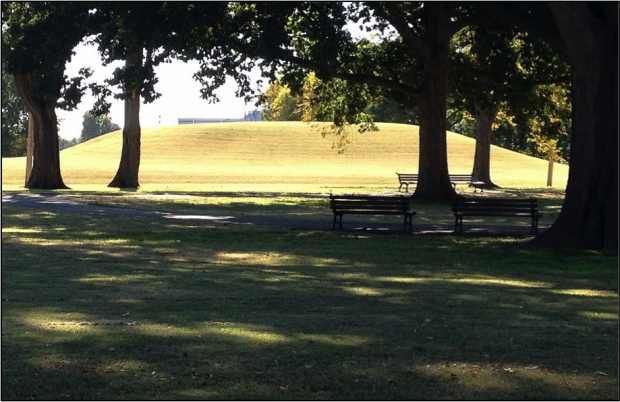Dulaney’s Districts
Putting neighborhoods on the National Register is an exhaustive, dedicated process. In this special series, the keeper of the Memphis Heritage Historic Properties Catalogue gives us snapshots of some wonderful but lesser-known historic neighborhoods.
Chickasaw Heritage Park (De Soto Park)
By John Dulaney
Chickasaw Heritage Park is not just another park. Native Americans who were part of the Preserve the Sacred Mounds Project group viewed it as a “sacred place, a place where our ancestors have been buried.” It represents a settlement that predates Memphis, going as far back as the early 16th Century.
From the park’s description in Memphis Heritage’s Historic Properties Catalogue: “Formerly the fortress of Chickasaw chief Chisca, the park features two ceremonial mounds that were built by Paleo-Indians. During the Civil War these same mounds were hollowed out and used for gun emplacements and munitions storage. The area is also believed to be where Spanish explorer Hernando DeSoto first viewed the Mississippi River in 1541. Early in the 1900s this park was called Jackson Mound or Jackson Mound Park, but it was renamed by the Memphis Park Commission in 1913 as DeSoto (later De Soto) Park.”

There have been minor archaeological investigations of, or incursions into, the site but nothing major, due in part to objections by Native Americans and others concerned in part about human burials there. Speculation is that the site may have last been used as a Native American village around 1500.
It was incorporated into Fort Pickering in 1798, when a watchtower may have been placed atop the larger mound. Changes continued when the area was occupied by Federal troops during the Civil War, and after the war when much of it was leased to a group that developed an amusement park; an 1888 map shows a dance pavilion, bandstand, and bowling alley (below).
A U.S. Marine Hospital was constructed on another part of the site in 1884, destroying one of the mounds, while WPA work on a roadway around the park in the 1930s affected another mound. Further disturbance of the site took place in the mid-1930s with the building of another hospital, and in 1966 and later when a public rest room, play area and basketball court were added. Of the original seven known mounds, only two still exist. The park was listed on the National Register in 1997.


Above Left: “Jackson Mound Park” shown on the 1888 Sanborn Fire Insurance Map included in the park’s National Register nomination. Above Right: Map of the Chickasaw Heritage Park used in its nomination form.
Read more about Memphis’ National Register properties and all of Dulaney’s Districts featured throughout this issue of StoryBoard Memphis.
This article and all of Dulaney’s Districts originally appeared in print Issue X, the August 2019 Neighborhood Issue, front page and pages 12, 23-25.
Sponsored by Captain & Co. Real Estate, LLC for their “Memphis Mondays” series. Look for Captain & Co.’s Memphis every Monday.


